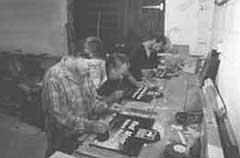|
|
|
 Breney Common and Creddacott Meadows are among the reserves on which you might glimpse the rare marsh fritillary. This species is the subject of a monitoring project in which any volunteer can easily become involved. Photo: David Chapman |
|
|
Looking back over the work carried out on our nature reserves this summer, issues of access are especially relevant. The maintenance and installation of access routes is an ongoing process and summer is the ideal time to do this work as the disturbance to wildlife is minimal. Another activity which has been keeping the reserves section busy this summer is ecological monitoring. More often than not this involves straying from the established access routes. Vegetation quadrats, invertebrate transects and mammal trapping sites are not always close to convenient paths so staff and volunteers regularly have to fight their way into the less accessible corners of the reserves.
|
New boardwalks Building boardwalks is one solution for creating access into the wetter areas of nature reserves, and new sections have been installed at Lower Lewdon and Carn Moor. Materials for these boardwalks have been provided from our own woodlands using a planking machine to supply sustainable and cheaper timber. Access work is ongoing at Red Moor and Breney Common on the Wilderness Trail, which will be a wonderful walk across these two reserves encompassing Helman Tor. Work at Breney Common and Halbullock Moor has included special provisions to provide access for the less able. |
|
|
|
|
Ecological monitoring This activity tends to take you off the beaten track and is a wonderful way of exploring nature reserves. We have a carefully planned programme of ecological monitoring which sometimes requires getting in an expert, but more often than not we rely on the help of dedicated volunteers. Our programme this summer has included vegetation monitoring at Red Moor, Ventongimps Moor, Redlake, Cottage Meadows and Loggan's Moor, as well as invertebrate monitoring at Creddacott Meadows. The monitoring at Creddacott included looking for the larval webs of the marsh fritillary butterfly. Butterfly Conservation is carrying out a national survey for this species, which occurs on a number of our nature reserves; if you would like to help with this work please contact the Trust. A lichen expert, or lichenologist, surveyed a number of our nature reserves and was very excited with what he found at Cabilla and Redrice Woods. I am pleased to be able to report a new housing development on Red Moor, where we are hoping the new inhabitants will be dormice. We have put up fifty dormouse boxes in an area of hazel coppice as part of a monitoring programme for this species.
|
New signs and leaflet As you are out and about on the nature reserves you may notice the appearance of some new signs in the coming months. Money from our Heritage Lottery Fund grant has enabled us to replace the old reserves signs which have CTNC on them with new signs which are designed in a style that matches those of other Wildlife Trusts all over the country. We are also in the process of producing a new reserves leaflet which will include all the new sites - a grand total of 46 nature reserves. Callum Deveney Trelonk hide As of 1st November 1999 the Trelonk hide at Ruan Lanihorne will have a new lock on its door. Keys will be available for loan from Trust HQ at Allet in return for a small deposit. Stuart Hutchings |

A sign of the times - notices are being updated in The
Wildlife Trusts' corporate style. Photo: Stuart Hutchings |
|